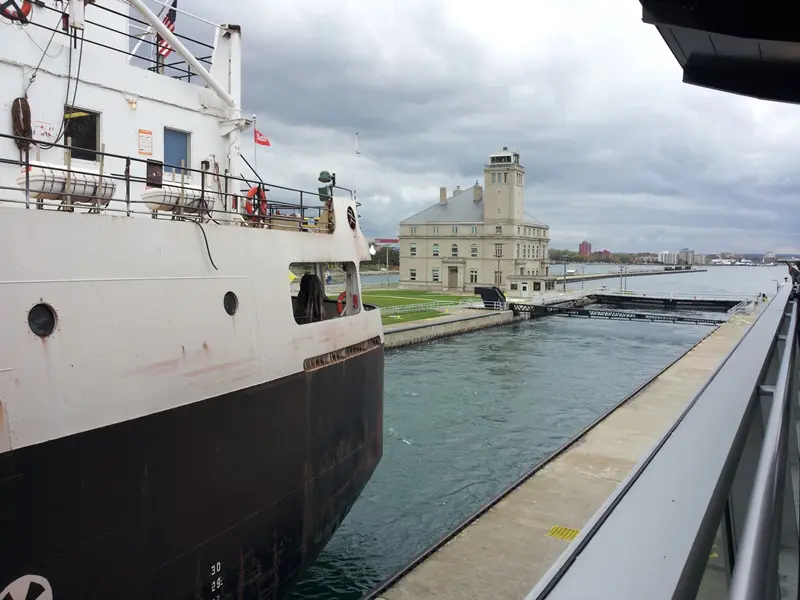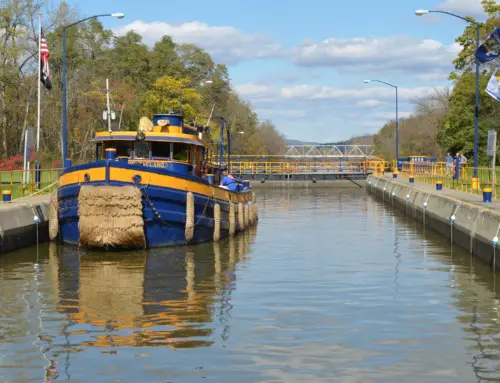Sault Ste. Marie is a beautiful city in Michigan’s Upper Peninsula, located on the St. Mary’s River, and home to Lake Superior State University. It’s also not far from the Great Lakes Shipwreck Museum and the picturesque sights of Tahquamenon Falls and Pictured Rocks. However, it is most famous for its Locks, which are an amazing feat of engineering and a great tourist attraction (especially if the tour includes a wedding rehearsal dinner with friends). Since the first modern lock was opened in June of 1855, I decided it would be a great topic for this month’s article.
Sault Ste. Marie is considered the oldest city in Michigan. Over 2,000 years ago, Native Americans began gathering here to fish and trap. The St. Mary’s River was known to have some of the best fishing in the region, so in the 1600s French missionaries and fur traders ventured into the territory. In 1668, the legendary Jesuit missionary Fr. Jacques Marquette named this first city of Michigan in honor of the Virgin Mary, Sault Ste. Marie. He also established the parish of Holy Name of St. Mary’s. It is the oldest parish and cathedral in Michigan, and the third oldest parish in the United States. If you’re curious, St. Augustine in Florida and Santa Fe in New Mexico are oldest.
On June 4, 1671, a European military officer and colonial agent Simon-Francois Daumont de Saint-Lusson left Quebec for what is now Sault Ste. Marie to claim the lakes of Huron and Superior, and the land surrounding them, for France. The French often tried to work with the native people through partnerships and treaties, so Lusson held a council. About 2,000 Native Americans from over fifteen different tribes attended, and voluntarily submitted their land. French gifts were exchanged for furs.
The abundant natural resources nearby, along with the placement of the river, made this area a very desirable plot of land. It was the center of the fur trading business in the 18th Century, so the French and British, who had begun establishing settlements in the 1700s, often fought over the area and the trading rights.
One of the leading civilians at this time was John Johnston, a Scots-Irish immigrant. In 1790 he was considered the first European settler to build a permanent home. A fur trader, he traveled often and spent the winter of 1790-1791 in what is now LaPointe, Wisconsin. There he met the Ojibwe chief and his family. They helped each other survive the winter, and Johnston became enthralled with Neengay, the daughter of the chief. He asked for her hand in marriage, but the chief told him to think about it over the next season. Johnston went home to Sault Ste. Marie, then returned to Wisconsin in 1792 where he married Neengay. The newlyweds settled in Johnston’s home in Sault Ste Marie. This union is one example of the many marriages between high-ranking European traders and the Ojibwe that solidified trading partnerships and helped in keeping the peace. The Johnston family became very prominent in the area, having eight children who spoke fluent French, Ojibwe and English. The family entertained trappers, explorers, traders and government officials of all races as the fur trade in the area brought in Ojibwe, Ottawa, Metis (a mix of native and European) and Europeans.
The St. Mary’s River is the only water connection between Lake Superior and the other Great Lakes, so it has always been very important for shipping. However, near the upper end of the river, the water level drops twenty-one feet over hard sandstone in a ¾ mile-long stretch, creating treacherous rapids and cascades. These rapids made it impossible for trading vessels to pass through. To get around the rapids, they would have to portage, which meant carrying all of their cargo, including their canoes, and walking along the river until it was safe to traverse. The trail the men would portage on was lined with stores, saloons, and services for the travelers. In 1797, a solution to control the rapids was decided upon and the first lock on the St. Mary’s River was built by the North West Fur Company on the northern side of the river to accommodate small boats and canoes.
Canal locks were developed in ancient China, and first used in Europe during the Middle Ages. They enable ships to go from one water level to another, making many more transportation routes possible. The earliest locks were called flash locks and were simple movable barriers across a canal or river. These barriers were called lock-gates and slowed the water flow which allowed water to build up behind the gate. When the gate was opened, a boat going downstream would be carried smoothly over the downhill drops and shallow areas by the surge of water. It was more difficult when a boat was heading upstream, as it would have to be hauled through the gate against the flow.

The first lock built in Sault Ste. Marie was destroyed by American forces during the War of 1812 and forty years would pass before another lock was discussed.
In 1817, following the War, the United States and Great Britain settled the boundary along the St. Mary’s River, and in 1820, the Treaty of the Sault was signed and the area was officially turned over to the United States. In June of 1821, Governor Lewis Cass went on an expedition to the region to establish an American hold over the land to the west of the St. Mary’s River. The next winter, American troops arrived and occupied the home site of Jean-Baptiste Nolin. In April of 1823, they began building a fort to protect the area.
This fort, named Fort Brady, was built where the French Fort Repentigny had been. Americans had continued concerns that the British would invade the United States from Canada, so U.S. Troops arrived in 1822 under the command of Colonel Hugh Brady. For years, the fort was a very important part of Sault Ste. Marie. It contained a large community garden and a cemetery and on holidays people would gather to watch the soldiers parade down Portage Street. Every spring, activities were held at the fort including foot races, horse races, dog races, and canoe races. Natives Americans were allowed to compete and frequently defeated American soldiers in canoe races.
Also in 1821, Jane Johnston, daughter of John Johnston married the first Indian Agent in the area, Henry Schoolcraft. Four years later, in 1825, Schoolcraft became a justice of the peace and was a leading civilian in Sault Ste. Marie. By this time, the Erie Canal opened and the number of settlers to the area increased dramatically. Many of these settlers brought their New England culture with them. Sault Ste. Marie grew significantly in the next few decades, especially the downtown area. In 1827, the Henry School opened, and a year later, the Baptist Mission was established. The Ojibwe community remained, staying mostly down by the river. Though the town was growing, life remained simple, even to the point that mail came by snowshoe and dog sleds in the winter.
In the 1850s it became apparent that a new lock was needed in the St. Mary’s River. Iron and copper had been found in the western part of the Upper Peninsula and the best way to transport it was through this waterway. In 1852, Congress passed an act that would finance the project, as well as grant 750,000 acres of public land to be used. E&T Fairbanks, a Vermont company investing in mineral resources in Michigan, won the contract to build the lock to required specifications within a two-year deadline. A man named Charles Harvey, an East Coast salesman, organized the project, which would actually include two locks.
The State lock, the first modern lock, was built on the south shore of the river and it opened in 1855. The steamship Illinois became the first ship to sail through the newly completed Soo Locks on June 13. The lock was officially maintained by the state of Michigan, but when a ship needed to lock up or down, the crew would ring a bell and citizens from the town would come to open and close the locks.
The building of this lock turned a noisy frontier town into a civilized community. Charles Harvey is credited with leading the charge, but the 1860s brought war to the country, and many things changed for all civilians. The garrison at Fort Brady was very lean as many soldiers were mobilized to fight and it remained unchanged until after the war. In 1866, soldiers at the fort had a new purpose: to guard the locks.
By the 1870s, Michigan passed legislation to turn the lock over to the Federal Government and Congress began approving funds to build a new lock. This new lock had technology that would reduce turbulence as boats passed through. When it was completed in 1881, it was taken over by the US Army Corps of Engineers and called the Weitzel Lock. Also during the 1870s, the government undertook improvements on Fort Brady, but many of the buildings were too dilapidated to be fixed, and in the 1880s, the government looked for a new location for the fort.
The 1870s and ‘80s saw a development boom in the city. In 1877, the Chippewa county courthouse was built. In 1878, the city’s first high school, Central High School, came to be. In 1881, St. James Episcopal Church was constructed, and in 1885, St. Mary’s Parochial School was built across the street from the cathedral. The city also built its first water power station during this period. All of this is evidence that the city of Sault Ste. Marie was expanding.
Sadly, in 1886, a fire ripped through the city, burning over half the business buildings. The civilians worked hard to rebuild and make the area even better. A year later, the railroad came to Sault Ste. Marie in the form of four lines. A depot and the railroad bridge over the St. Mary’s River was also built. Unfortunately, Fort Brady was eventually abandoned in 1892 after being moved to Ashmun Hill, where Lake Superior State University now sits.
As time passed, more work and updates were needed on the locks, especially in terms of size. The State locks were now too small for the increasing boat sizes. In 1896, work on the Poe lock began to replace the small, outdated locks. This lock would be the first to use lock gates made of steel instead of wood. The builders wanted to enable four ships to lock at the same time. This feat was finished in 1896 and the city held a water parade on August 3 to celebrate.
On August 27, 1896 another large fire tore through the city after a gas line exploded in the John Navin Restaurant. Many businesses burned, but the fire gave the city the opportunity to invest in new and better construction. Several large industries were established with neighborhoods surrounding them.
In the 1900s, the area below the former Fort Brady was filled in with material from digging the Poe Lock and became Brady Park, giving the waterfront a new look. By 1905, boats traversing the Great Lakes were as big as 569 feet and had to be locked one at a time when passing through the St. Mary’s River. In response to this, another new lock was planned in 1914. This new lock is known as the Davis Lock. It was designed to lock up to four vessels at a time. This was also the first lock to be made with concrete walls instead of stone masonry. It used electric winding machines to open and close the gates.
1905 marked the 50th Anniversary of the first modern lock being opened. The city celebrated with speakers and a marine parade. To commemorate the locks, a granite obelisk was erected where Fort Brady used to be that told the history of the lock’s construction.
At the same time the Davis lock was being built, another lock was being planned. This would accommodate even more and bigger boats.
After the Sabin Lock opened in 1919, the Weitzel Lock from 1881 was not being used nearly as much because of the newer, updated locks surrounding it. By 1936, the waters in the St. Mary’s River had been deepened to 24 feet, and shipping companies began asking for a new, deeper lock to get their boats and cargo through.
This latest project gained even more support when the United States was drawn into World War II. Most of the iron used in the war effort came through the locks from mines at the west end of Lake Superior. The country needed to maintain a steady supply of iron ore to steel mills in order to uphold national security. Since there was a threat of foreign attack, barrage balloons were constantly seen around town. Their goal was to keep any German planes from getting low enough to drop a bomb on the locks.
This new lock, aptly named the MacArthur lock, was completed in 1943 and had walls thick enough to absorb torpedo hits. The 1940s were also when the locks were fenced off.
In 1968, another lock was built, replacing the Poe lock but maintaining the name. This new lock would be larger and deeper than any lock so far. It was redesigned after the initial construction, but finally completed in 1968. Four years later, it brought through the first 1,000-foot long vessel on the Great Lakes.
Our ever-changing Soo Locks continue to evolve and improve with time, and it is mesmerizing to watch the huge freighters rise up, then go down in a truly remarkable feat of engineering. I continue to enjoy watching this view whenever I have the chance to visit this remarkable, historic city.







Leave A Comment
You must be logged in to post a comment.